Submitted:
04 December 2023
Posted:
05 December 2023
You are already at the latest version
Abstract
Keywords:
1. Introduction
2. Materials and Methods
- (1)
- Antenna 1: the number of marginal robust setae on peduncular article 3
- (2)
-
Antenna 2: developmental stage of incrassation of peduncle1. none (Figure 1A)2. slight (Figure 1B)3. distinct (Figure 1C)
- (3)
-
Gnathopod 1: cusp on dactylus1. none (Figure 2A)2. rudimentary (Figure 2B)3. distinct (Figure 2C)
- (4)
- Gnathopod 1: length ratio of propodus to carpus
- (5)
-
Gnathopod 2: posterior cusp on coxa2. medium3. sharp (Figure 3C)
- (6)
-
Gnathopod 2: developmental stage of mid-notch on palmar margin1. none (Figure 4A)2. slight (Figure 4B)3. distinct (Figure 4C, white arrow)
- (7)
- Gnathopod 2: the number of robust setae on posterior margin of propodus (Figure 4C, black arrow)
- (8)
- Pereopod 4: length ratio of carpus to width
- (9)
-
Pereopod 6: development of protrusion on posterior lobe of coxa1. not protruded (right angled) (Figure 5A)2. slightly protruded (Figure 5B)3. distinctly protruded (Figure 5C)
- (10)
-
Pereopod 7: developmental stage of incrassation of carpus1. none (Figure 6A)2. slight (Figure 6B)3. distinct (Figure 6C)
- (11)
- Pleopods 2 and 3: the number of robust setae on outer margin of peduncle
- (12)
- Telson: the number of robust setae per lobe
3. Results
3.1. The number of marginal robust setae on propodus of gnathopod 2 (Figure 7)

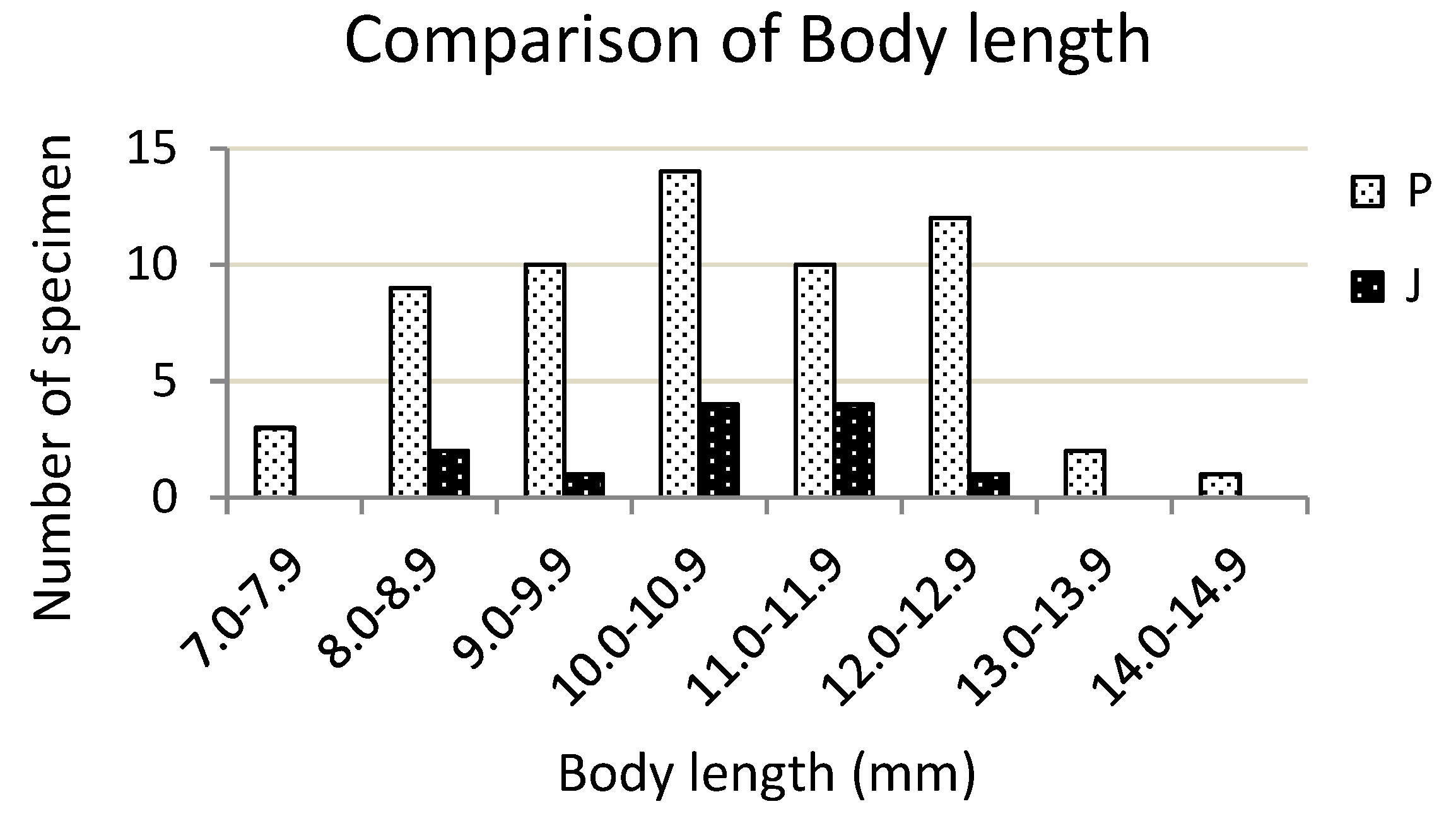
3.2. Posterior cusp on coxa of gnathopod 2 (Figure 9)
3.3. Incrassation of carpus of pereopod 7 (Figure 10)

3.4. Cusp on dactylus of gnathopod 1 (Figure 11)

3.5. The number of marginal robust setae on peduncular article 3 of antenna 1 (Figure 12)
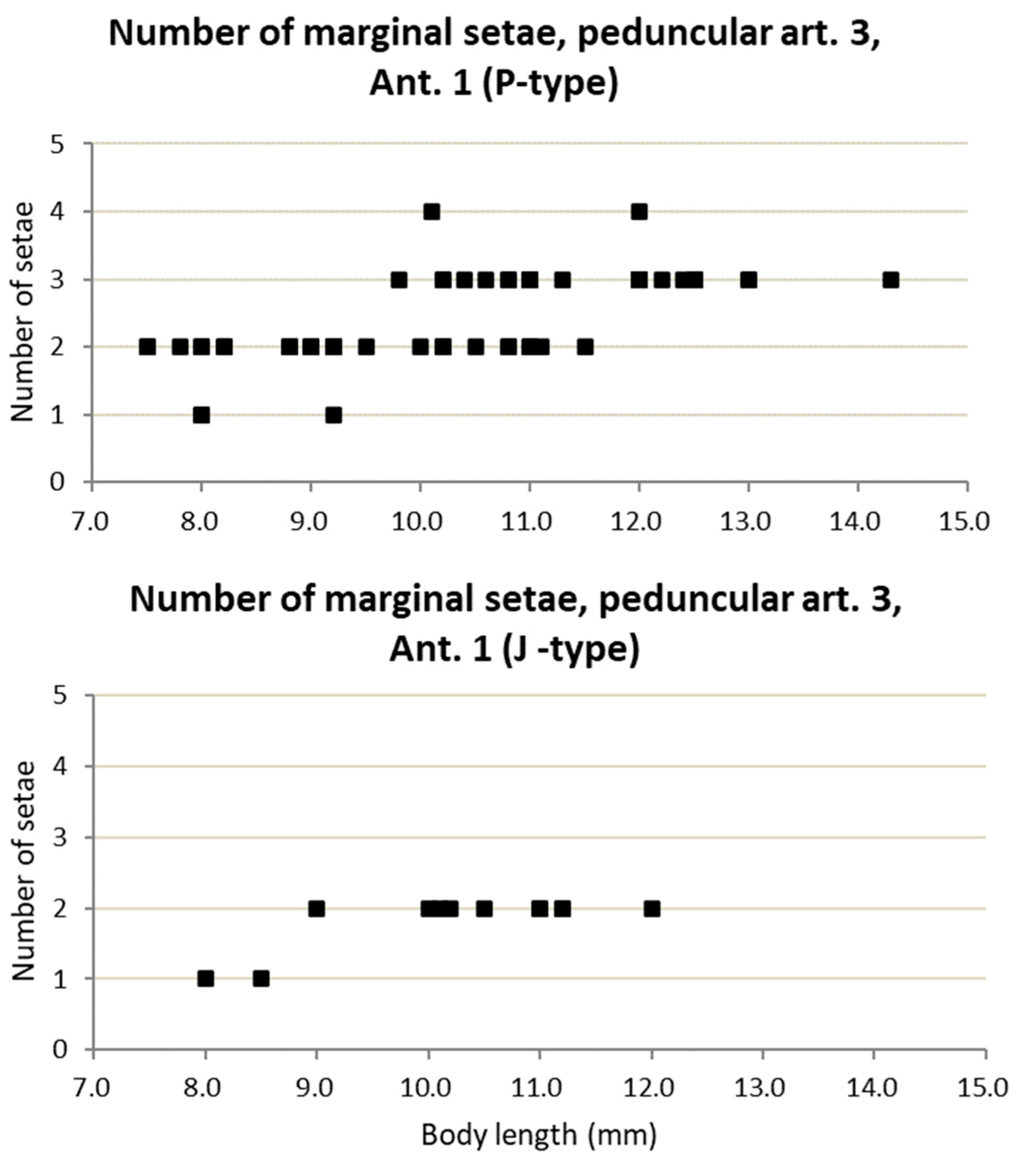
3.6. Incrassation of peduncle of antenna 2 (Figure 13)

3.7. Length ratio of propodus to carpus of gnathopod 1 (Figure 14)

3.8. Mid-notch on palm of gnathopod 2 (Figure 15)

3.9. Length ratio of carpus to width of pereopod 4 (Figure 16)

3.10. Protrusion on coxa of pereopod 6 (Figure 17)
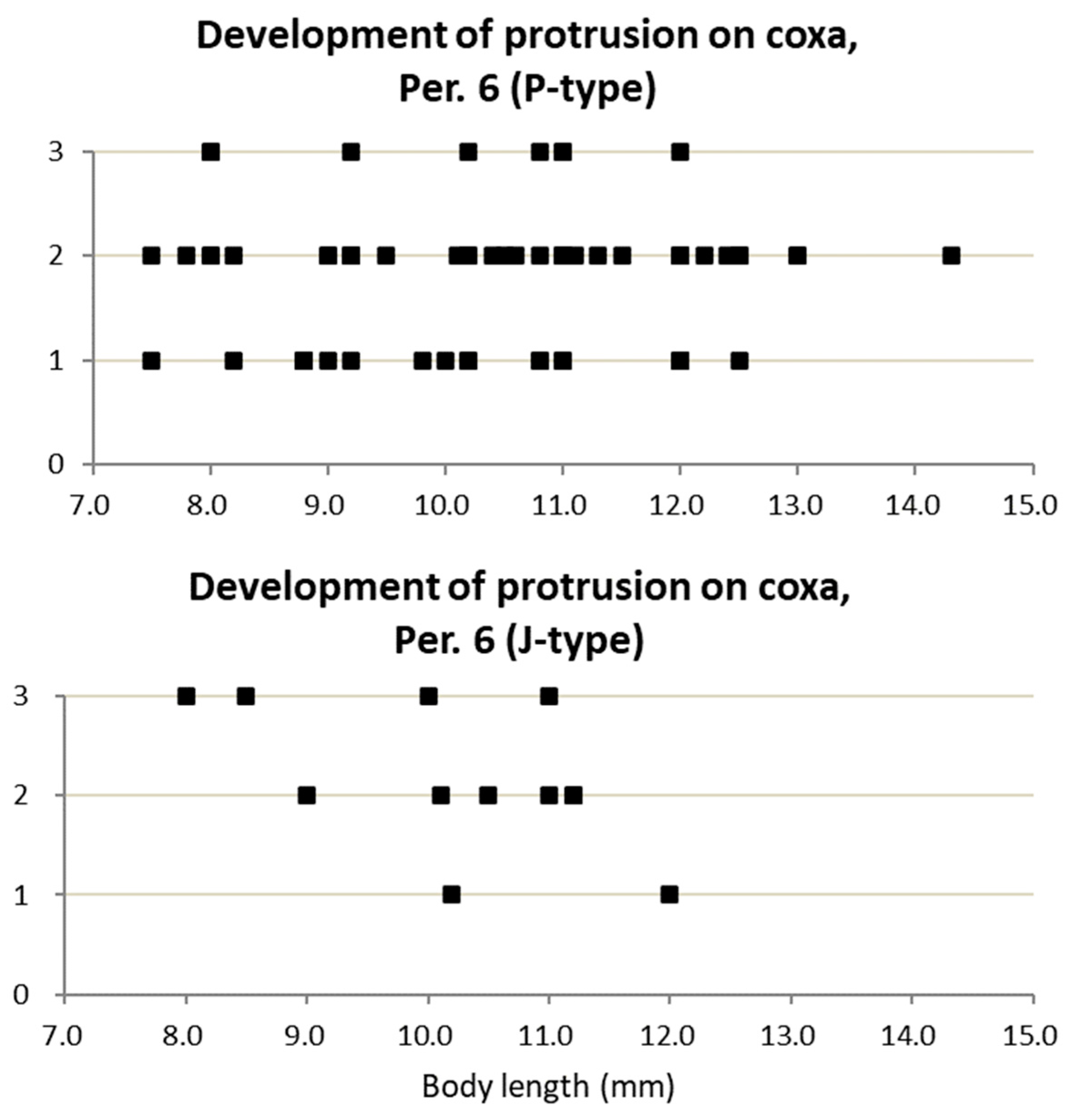
3.11. The number of marginal robust setae on peduncle of pleopod 2 (Figure 18) and pleopod 3 (Figure 19)

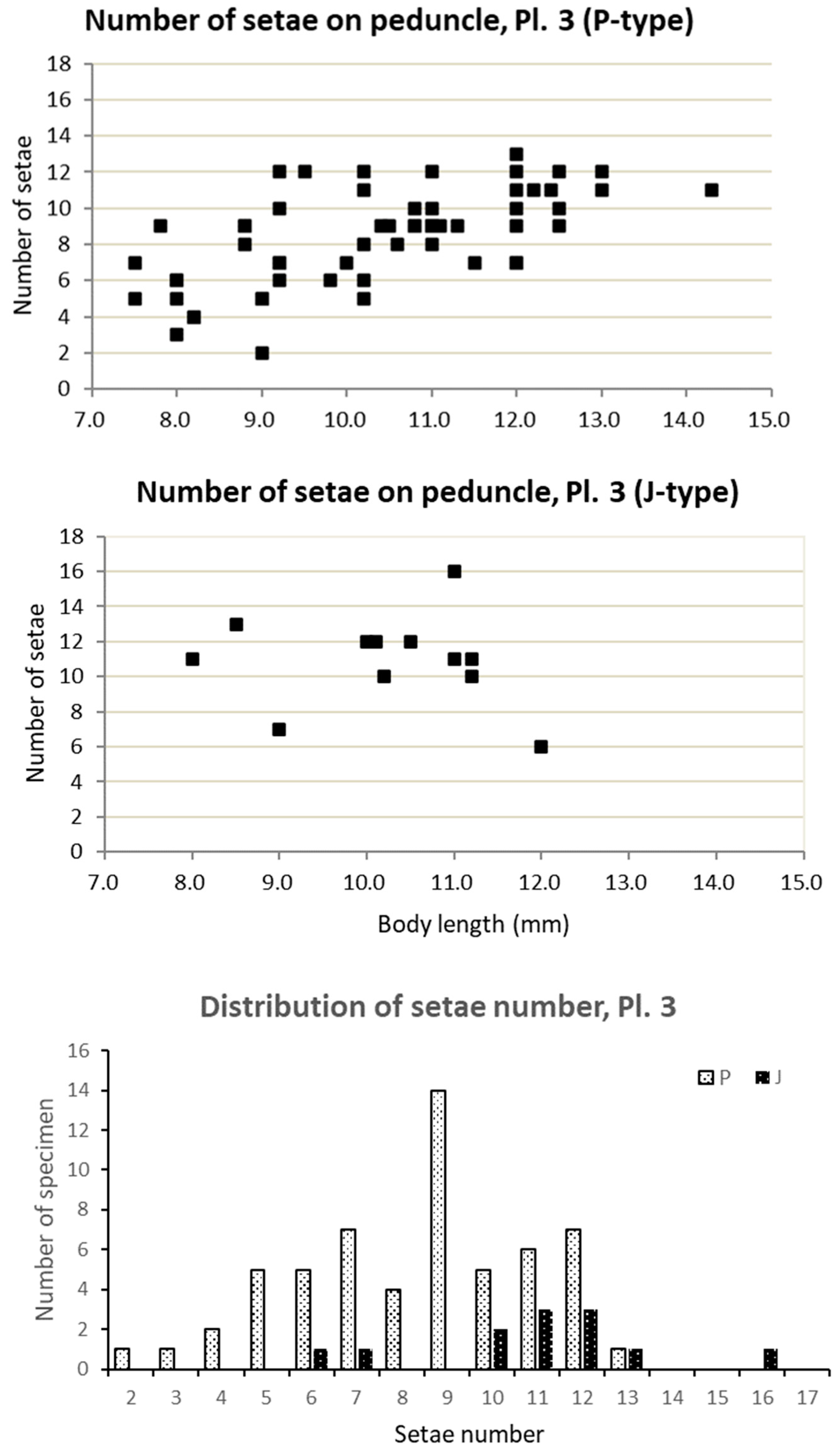
3.12. The number of robust setae on left lobe of telson (Figure 20)
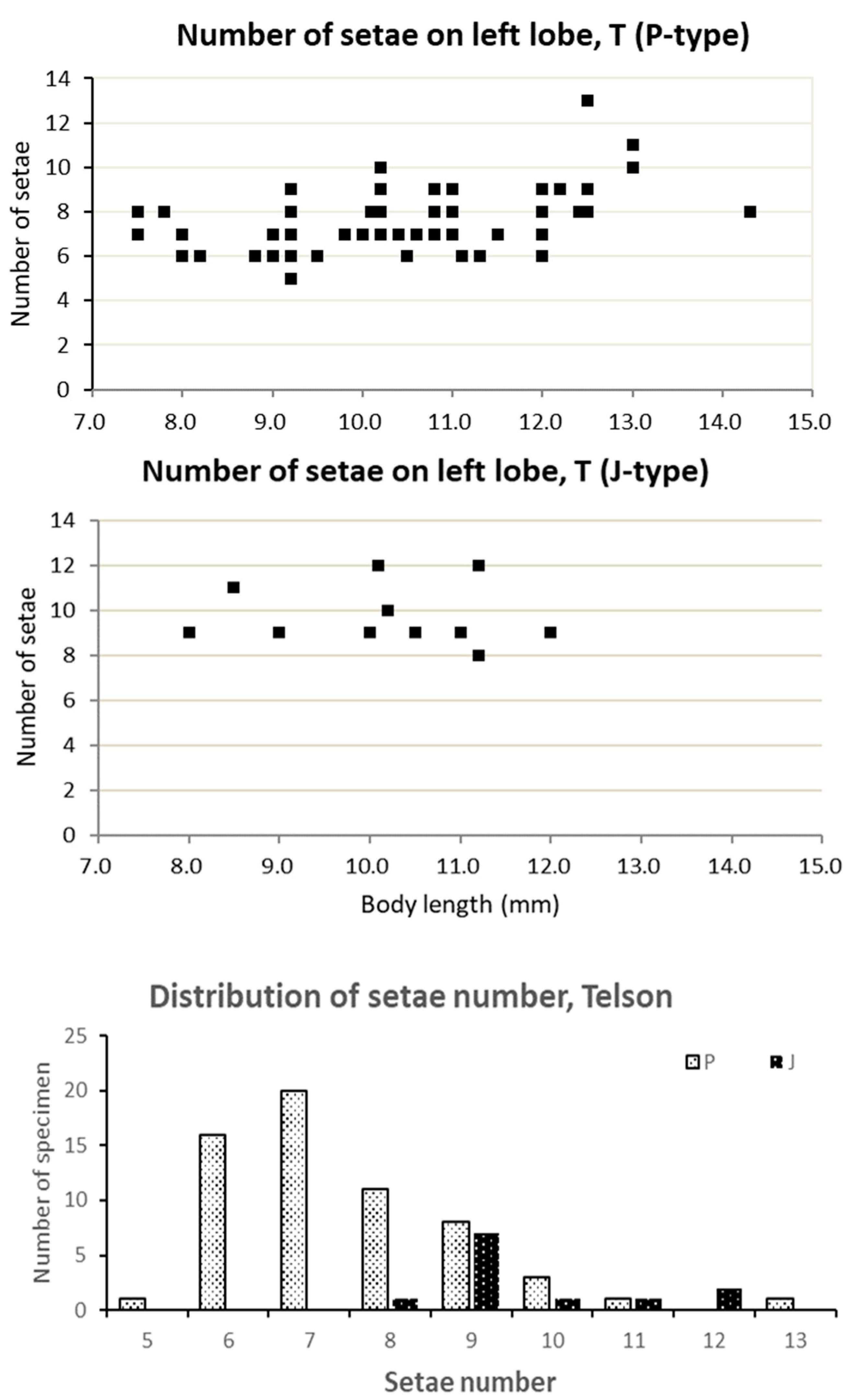
Acknowledgments
Conflicts of Interest
Appendix
References
- Bousfield, E.L. Shallow-water gammaridean Amphipoda of New England, Cornell University Press: London, U.K., 1973; xii+317 pp.
- Morino, H. Studies on the Talitridae (Amphipoda, Crustacea) in Japan II. Taxonomy of sea-shore Orchestia, with notes on the habitats of Japanese sea-shore talitrids. Publ. Seto Mar. Biol. Lab. 1975, 22, 171–193. [Google Scholar] [CrossRef]
- Lincoln, R.J. British Marine Amphipoda: Gammaridea. Brit. Mus. (Nat. Hist.), London, U.K., 1979, vi+658 pp.
- Iwasa, M. Japanese Talitridae. Jour. Fac. Sci., Hokkaido Imp. Univ. Ser. VI, Zool. 1939, 6, 255–296. http://hdl.handle.net/2115/27016.
- Stephensen, K. Some Japanese Amphipods. Vidensk. Medd. Dansk. Naturh. Foren. 1945, 108, 25–88. [Google Scholar]
- Bousfield, E.L. The amphipod superfamily Talitroidea in the northeastern Pacific region. 1. Family Talitridae: Systematics and distributional ecology. Natl. Mus. Nat. Sci., Publ. Biol. Oceanogr. 1982, 11. vii+73 pp. [Google Scholar]
- Bulycheva, A.I. The sand-fleas of the USSR and adjoining waters (Amphipoda-Talitridae). Keys to the fauna of the USSR. Zool. Inst., Acad. Sci. USSR 1957, 65. 186p. (In Russian)
- Jo, Y.W. Talitridae (Crustacea – Amphipoda) of the Korean coasts. Beaufortia 1988, 38, 153–179. [Google Scholar]
- Miyamoto, H.; Morino, H. Taxonomic studies on the Talitridae (Crustacea, Amphipoda) from Taiwan. II The genus Platorchestia. Publ. Seto Mar. Biol. Lab. 2004, 40, 67–96. [Google Scholar] [CrossRef]
- Serejo, C.S.; Lowry, J.K. The coastal Talitridae (Amphipoda: Talitroidea) of Southern and Western Australia, with comments on Platorchestia platensis (Krøyer, 1845). Rec. Aust. Mus. 2008, 60, 161–206. [Google Scholar] [CrossRef]
- Kim, M.-S.; Min, G.-S. First record of Platorchestia monodi (Crustacea: Amphipoda: Talitridae) from the Pacific Region. Korean J. Syst. Zool. 2011, 27, 205–212. [Google Scholar] [CrossRef]
- Lowry, J.K.; Myers, A.A. Platorchestiinae subfam. nov. (Amphipoda, Senticaudata, Talitridae) with the description of three new genera and four new species. Zootaxa 2022, 5100, 1–53. [Google Scholar] [CrossRef] [PubMed]
- Kim, M.-S.; Jung, J.-H.; Min, G.-S. A new beach-hopper, Platorchestia parapacifica n. sp. (Amphipoda: Talitridae), from South Korea, with molecular phylogeny of the genus Platorchestia. Jour. Crust. Biol. 2013, 33, 828–842. [Google Scholar] [CrossRef]
- Myers, A.A.; Lowry, J.K. A phylogeny and classification of the Talitroidea (Amphipoda, Senticaudata) based on interpretation of morphological synapomorphies and homoplasies. Zootaxa 2020, 4778(2), 281–310. [Google Scholar] [CrossRef]
- Morino, H. Amphipoda. In Pictorial Keys to Soil Animals of Japan, 2nd ed.; Aoki, J., Ed.; Tokai University Press: Hadano, Japan, 2015; pp. 1069–1089. [Google Scholar]
- Morino, H. Studies on the Talitridae (Amphipoda, Crustacea) in Japan III. Life history and breeding activity of Orchestia platensis Krøyer. Publ. Seto Mar. Biol. Lab. 1978, 24, 245–267. [Google Scholar] [CrossRef]
- Derzhavin, A.N. Talitridae of the Soviet coast of the Japan Sea. Issledovanye Faune Morey SSSR 1937, 23, 87–112, (In Russian with English summary). [Google Scholar]
- Stock, J.H.; Biernbaum, C.K. Terrestrial Amphipoda (Talitridae) from Ascension and Saint Helena (South Central Atlantic). J. Nat. Hist. 1994, 28, 795–811. [Google Scholar] [CrossRef]
- Myers, A.A.; Lowry, J.K. The beach-hopper genus Platorchestia (Crustacea: Amphipoda: Talitridae) on Atlantic Ocean coasts and on those of associated seas. Rec. Aust. Mus. 2023, 75(4), 485–505. [Google Scholar] [CrossRef]







| # | Locality | Sampling date | Sample size | Specimen #-#: Body length (NSMT-Cr XXXXX) | Collector | Remarks |
|---|---|---|---|---|---|---|
| 1 | Sakanoshita, Wakkanai, Hokkaido | 24 Jun. 1971 | 3 | 1-1: 8.8 mm (27043); 1-2: 11.5 mm (27042); 1-3: 12.5 mm (27041) |
H. Morino | seashore |
| 2 | Lake Abashiri, Abashiri, Hokkaido | 18 May 2004 | 2 | 2-1: 9.2 mm (27268); 2-2: 10.2 mm (27269) |
K. Wada | brackish lake |
| 3 | Aikappu, Akkeshi, Hokkaido | 22 Jun. 1971 | 3 | 3-1: 10.6 mm (27033); 3-2: 11.3 mm (27034); 3-3: 12.0 mm (27032) |
H. Morino | seashore |
| 4 | Esashi-oyama, Hokkaido | 18 Jun. 1971 | 3 | 4-1: 9.0 mm (27024); 4-2: 11.0 mm (27026); 4-3: 12.0 mm (27025) |
H. Morino | seashore |
| 5 | Torikarasuhama, Oshima-ohshima Is., Hokkaido | 10 Oct. 1990 | 1 | 5-1: 11.2 mm (27226) | Y. Harada and K. Kuribayashi | seashore |
| 6 | Togahama, Oga, Akita | 16 Jun. 1971 | 1 | 6-1: 10.8 mm (27017) | H. Morino | seashore |
| 7 | Takashiro-hama, Onagawa, Miyagi | 27 Jun. 1971 | 3 | 7-1: 10.2 mm (27052); 7-2: 10.5 mm (27051); 7-3: 12.0 mm (27053) |
H. Morino | seashore |
| 8 | Hiraiso, Hitachinaka, Ibaraki | 5 Nov. 2015 | 3 | 8-1: 10.2 mm (27310); 8-2: 10.2 mm (27311); 8-3: 12.0 mm (27312) |
H. Morino | seashore |
| 9 | Shinpo, Noto, Ishikawa | 14 Jun. 1971 | 2 | 9-1: 10.8 mm (27011); 9-2; 12.0 mm (27012) |
H. Morino | seashore |
| 10 | Akasaki, Tsuruga, Fukui | 6 Jun. 1976 | 2 | 10-1: 11.0 mm (27314); 10-2: 13.0 mm (27315) |
H. Miyamoto | Seashore |
| 11 | Saburi River, Ooi, Fukui | 6 May 1977 | 2 | 11-1: 10.5 mm (27336); 11-2: 11.0 mm (27335) |
H. Miyamoto | estuary |
| 12 | Takahama, Ooi, Fukui | 24 May 1971 | 2 | 12-1: 10.4 mm (27003); 12-2: 12.2 mm (27004) | H. Morino | seashore |
| 13 | Daito Fisheries Port, Isumi, Chiba | 23 Jun. 1994 | 2 | 13-1: 9.0 mm (27237); 13-2: 10.1 mm (27236) |
H. Morino | seashore |
| 14 | Uchiura Bay, Amatsu-kominato, Chiba | 29 Jun. 1971 | 3 | 14-1: 11.0 mm (27057); 14-2: 12.0 mm (27058); 14-3: 13.0 mm (27059) |
H. Morino | seashore |
| 15 | Funemisaki, Torishima Is., Izu Tokyo | 29 Jan. 2017 | 2 | 15-1: 10.2 mm (27353); 15-2: 11.0 mm (27352) |
T. Torii | seashore |
| 16 | Minamijima Is., Ogasawara, Tokyo | 13 Aug. 1989 | 1 | 16-1: 8.0 mm (27217) | H. Morino | seashore, (incl. slide mount) |
| 17 | Koajiro, Misaki, Kanagawa | 30 Jun. 1971 | 3 | 17-1: 9.2 mm (27065); 17-2: 9.5 mm (27066); 17-3: 10.2 mm (27064) |
H. Morino | seashore |
| 18 | Kawajiri River, Wachi, Tahara, Aichi | 24 Nov. 1974 | 2 | 18-1: 11.0 mm (27323); 18-2: 12.0 mm (27322) |
H. Miyamoto | estuary |
| 19 | Hatakejima Is., Tanabe Bay, Wakayama | 13 Mar. 1972 | 3 | 19-1: 12.0 mm (27284); 19-2: 12.4 mm (27285); 19-3: 14.3 mm (27286) |
H. Morino | seashore (Morino, 1978) |
| 20 | Hatakejima Is., Tanabe Bay, Wakayama | 13 Aug. 1972 | 3 | 20-1: 7.8 mm (27298); 20-2: 8.0 mm (27296); 20-3: 8.0 mm (27297) |
H. Morino | seashore (Morino, 1978) |
| 21 | Hatakejima Is., Tanabe Bay, Wakayama | 13 Dec. 1972 | 3 | 21-1: 8.8 mm (27305); 21-2: 10.8 mm (27304); 21-3: 11.0 mm (27303) |
H. Morino | seashore, (Morino, 1978) |
| 22 | Suetsune, Tottori | 22 May 1971 | 4 | 22-1: 9.2 mm (26996); 22-2: 10.0 mm (26997); 22-3: 11.0 mm (26995); 22-4: 11.2 mm (26994) |
H. Morino | seashore |
| 23 | Bentenzaki, Tamano, Okayama | 24 Sept. 1971 | 1 | 23-1: 8.5 mm (27092) | H. Morino | seashore |
| 24 | Karakohama, Imabari, Ehime | 25 Sept. 1971 | 3 | 24-1: 8.0 mm (27100), 24-2: 8.0 mm (27102); 24-3: 9.2 mm (27101) |
H. Morino | seashore |
| 25 | Shigenobu River, Matsuyama, Ehime | 19 Apr. 2004 | 1 | 25-1: 10.0 mm (27265) | K. Wada | estuary |
| 26 | Urado, Higashi-minamiura, Kochi | 30 Sept. 1971 | 2 | 26-1: 7.5 mm (27116); 26-2: 9.0 mm (27115) |
H. Morino | seashore |
| 27 | Tsuyazaki, Fukuoka | 12 May 1971 | 2 | 27-1: 10.8 mm (26979); 27-2: 12.5 mm (26980) |
H. Morino | seashore |
| 28 | Sesegushi, Kagoshima | 17 May 1971 | 3 | 28-1: 10.1 mm (26986); 28-2: 11.0 mm (26987); 28-3: 12.5 mm (26988) |
H. Morino | seashore |
| 29 | Akaogi, Amami-Oshima Is., Kagoshima | 30 Jul. 1971 | 3 | 29-1: 7.5 mm (27082); 29-2: 8.2 mm (27083); 29-3: 9.0 mm (27081) |
H. Morino | seashore |
| 30 | Awase Port, Awase, Okinawa Is. Okinawa | 27 Mar. 1975 | 2 | 30-1: 8.2 mm (27138); 30-2: 9.8 mm (27139) |
H. Morino | seashore |
| 31 | Sonai, Iriomote Is., Okinawa | 30 Mar. 1975 | 3 | 31-1: 8.8 mm (27146); 31-2: 9.2 mm (27145); 31-3: 11.1 mm (27144) |
H. Morino | seashore |
| Total 73 | ||||||
| Specimen or species | P-type | J-type | P. crassicornis | P. joi | P. pacifica | P. parapacifica | P. munmui | P. monodi | |
| Referred author(s) | present paper | present paper | Jo [8] | Miyamoto & Morino [9] |
Miyamoto & Morino [9] |
Kim et al. [13] | Jo [8] | Kim & Min [11] | |
| Body length (mm) | 7.5–14.3 | 8.0–12.0 | 12.5 | 8–11 | 10 | 19.2 | 13.2 | 9.3 | |
| Taxonomic opinions of Lowry & Myers, 2022 [12] |
D. joi | D. pseudojoi |
D. pacifica (?D. mie & ?D. hatakejima) |
D. parapacifica | P. koreaensis | ||||
| Characters | |||||||||
| 1 | Gn 2, number of setae on propodus | 0–3(1) | 4–7 (4–6) | 7 (fig), several (text) |
3–5 | 0 | 1 (fig), bare (text) | 1 | 1 (fig), bare (text) |
| 2 | Gn 2, cusp on coxa | S (rarely M) | B | B or M | B | S | S | S | S (fig), obtuse (text) |
| 3 | Per 7, incrassation of carpus | D*, S, N | N (rarely D) | N or S | N or S | D | D | D | N |
| 4 | Gn 1, cusp on dactylus | D, R, N | N | N | N | D, R | N | D | D |
| 5 | Ant 1, number of setae on peduncular article 3 | 1–4 (2, 3)** | 1–2* | 2 (Kim et al, 2013) | 0 | 1, 2 | 4 | 1, 2 | 1 (Kim et al. 2013) |
| 6 | Ant 2, incrassation of peduncle | 2, 3 (rarely 1)** | 1–3 | 3 | 2, 3 | 3 | 3 | 3 | 2 |
| 7 | Gn 1, length ratio of propodus to carpus | 0.58–0.74 (0.65–0.68) |
0.57–0.68 (0.63-0.68) |
0.63 | 0,71 (fig), ca 0.6 (text) |
0.71 (fig), ca 0.6 (text) |
0.66 (fig), 0.63 (text) |
0.73 | 0.69 (fig), 0.63 (text) |
| 8 | Gn 2, mid-notch on palm | 1–3** | 2, 3 | 3 | 2 | 1, 2 | 3 | 3 | 2 |
| 9 | Per 4, length ratio of carpus to width | 1.13–1.78 (1.40-1.49) |
1.33–1.71 (1.30–1.39) |
1.48 | 1.69 | 1.64 | 1.31 | 1.09 (fig), ca 1.0 (text) |
1.77 |
| 10 | Per 6, protrusion of lobe on coxa | 1–3 | 1–3 | 1 or 2 | 1, 2 | 3 | 2, 3 | 1 | 1 |
| 11 | Pl 2, number of setae on peduncle | 3–15 (8)** | 6-17 (11) | 10~ | 4 (fig), several (text | 3 | 7 | 5 | 1 |
| 12 | Pl 3, number of setae on peduncle | 2–13 (9)** | 6–16 (11–12) | 10~ | 8 | 9 | 9 | 9 | 2 |
| 13 | T, number of setae on left lobe | 5–13 (7)** | 8–12 (9) | 8 | 8 | 6 | 10 | 8 | 5 |
Disclaimer/Publisher’s Note: The statements, opinions and data contained in all publications are solely those of the individual author(s) and contributor(s) and not of MDPI and/or the editor(s). MDPI and/or the editor(s) disclaim responsibility for any injury to people or property resulting from any ideas, methods, instructions or products referred to in the content. |
© 2023 by the authors. Licensee MDPI, Basel, Switzerland. This article is an open access article distributed under the terms and conditions of the Creative Commons Attribution (CC BY) license (http://creativecommons.org/licenses/by/4.0/).




